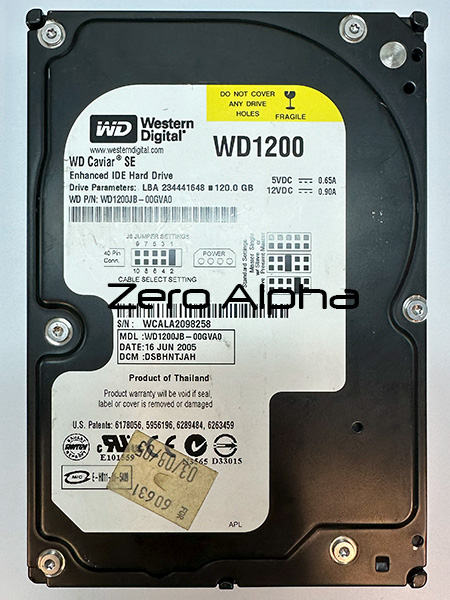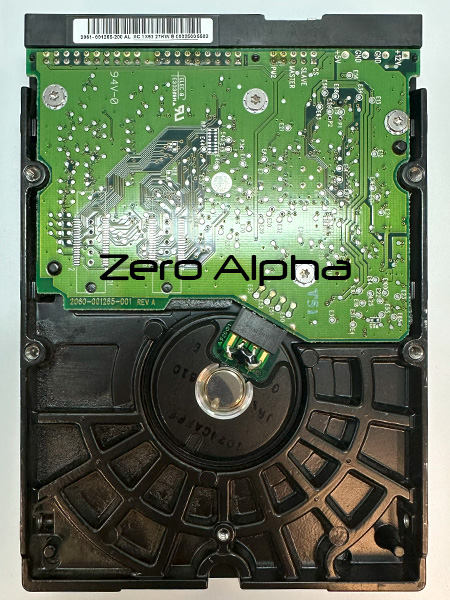Western Digital WD1200JB-00GVA0 Data Recovery
In the case of the Western Digital WD1200JB-00GVA0, this clicking is often associated with mechanical issues within the drive. It may signify problems with the read/write heads, spindle motor, or other vital components crucial for proper drive function.

Common Causes of Clicking:
-
Head Crash: The read/write heads may crash onto the platters, leading to the clicking sound and potential data loss.
-
Stiction: Stiction occurs when the spindle motor fails to spin up the platters, causing the heads to get stuck and produce a repetitive clicking noise.
-
Firmware Corruption: Issues with the drive's firmware can also contribute to clicking problems.
Our Approach to WD1200JB-00GVA0 Data Recovery:
At Zero Alpha Data Recovery, we employ a systematic and proven approach to address clicking WD1200JB-00GVA0 drives.
-
Diagnosis: Our experts begin by conducting a thorough diagnosis to identify the root cause of the clicking issue. This involves assessing the physical and logical components of the drive, including the read/write heads, spindle motor, and firmware.
-
Cleanroom Environment: In cases of mechanical failure, we perform data recovery in a certified cleanroom environment. This ensures that delicate components are handled in a controlled and contaminant-free space.
-
Head Replacement: If the clicking is attributed to a head crash, our technicians may opt for head replacement. This delicate procedure involves replacing damaged heads with compatible and functioning ones to restore access to the data.
-
Spindle Motor Repair: Stiction-related clicking can be addressed by repairing or replacing the spindle motor, allowing the platters to spin freely.
-
Firmware Restoration: Firmware issues are resolved through specialized tools and techniques designed to restore the drive's firmware to a stable state.
Conclusion:
The Western Digital WD1200JB-00GVA0, plagued by the ominous clicking sound, poses a formidable challenge to data recovery. However, at Zero Alpha Data Recovery, we stand ready to tackle such issues head-on, leveraging our expertise, advanced tools, and a commitment to delivering unparalleled results.
If you find yourself facing the daunting prospect of data loss due to a clicking WD1200JB-00GVA0 drive, trust Zero Alpha Data Recovery to navigate the complexities of data recovery and breathe new life into your valuable information. Our one-year anniversary marks a year of successfully overcoming data recovery challenges, and we look forward to continuing this journey of restoring data and ensuring peace of mind for our clients.

PCB 2060-001265-001 REV A
Data Recovery Log:
1Dec2023: Pata drive, clicking and spinning down,detects into kernel mode. This drive is from 2005 and has lasted almost 20 years. But fails to detect now and makes very bad clicking and clunking sounds. You can get a better id if you wait for it to come ready and enter the correct utillity which is Caviar Cyl 32bit.
Model : WDC WD1200
Firmware : 21.02J
Capacity : 125 GB (244 260 576)
HDD geometry loading.................... : Ok
Cyl Count............................... : 83970
Head Count.............................. : 3
SPT..................................... : 900
RAM:
Zone allocation table................... : Ok
ROM version............................. : 21.DC.
SA FW version........................... : ......
Link table version...................... : 02.GA.
Serial ROM:
Read ROM................................ : Ok
Heads configuration..................... : From map
Heads number............................ : 6
The number of heads in use.............. : 3
Disabled heads.......................... : Yes
Head map................................ : 0,1,5
Service area:
Modules table loading .................. : Drive is not ready
Configuration loading................... : Drive is not ready
Translation overlay checking (Copy 0)... : Not found in modules directory
Translation overlay checking (Copy 1)... : Not found in modules directory
Using Kernel Mode Jumpers
After configuring the jumpers, we can power on the drive and enter the Caviar utility. The drive will not ID - run the utility anyway, selecting kernel mode and autodetecting the correct family (32 bit in this case).
Next we need to initialise the drive. The most important change here is modification of the head map to disable the damaged physical head.

The default head map is 0 1 5 0 0 0. Physical head 5 is damaged, so we can effectively disable it by modifying the head map to 0 1 0 0 0 0. The drive may stay busy for a moment after writing the new head map and fail to initialise, in which case option 3 should be repeated once the drive is ready.
At this point we have access to the data area, but we notice that the drive capacity is wrong (changing capacity via module 0x42 did not resolve this).

This massive capacity causes issues when creating a data extractor task.
Looking at the more detailed drive ID, we observe that the normal LBA mode capacity looks relatively normal and it's the LBA48 mode capacity that is bad.
![]()
If we untick the "Read Drive ID" option when creating the task, we are prompted to input the max LBA. This can simply be read from the drive label.
